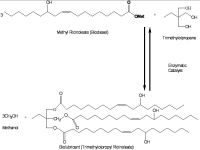Base oils can be classified as minerals or synthetics, depending on their source or production process. Lubricant’s world market is about 35 million tons per year and biolubricants represent approximately 1% of this total. But, the biolubricant’s market is growing at nearly 10% per year. When compared to mineral base stocks (mainly API group I), biolubricants show some advantages: lower toxicity and volatility, biodegradability, better lubricity, higher flash point and viscosity index (VI). However there are some limitations such as oxidative and hydrolytic instability.
Brazil is the third largest producer of castor beans. Castor oil has nearly 90% of ricinoleic acid, which differentiates it from all vegetable oils in terms of viscosity. Soybean and jatropha were also chosen because of their abundance in Brazil and their fatty acid profile.
Lipases are enzymes that act on the ester bonds of several compounds. They are produced from animal, vegetable and microbian sources and may have activity in a pH between 4 and 9, and in temperatures from 25 to 70°C.
In this work, three commercial lipases were studied: Rhizomucor miehei (Lipozyme IM RM, Novozymes), Candida antarctica (Novozym 435, Novozymes) and Candida rugosa (Lipomod 34P, Biocatalysts), in order to catalyze a transesterification reaction between a methyl ester (biodiesel) (castor, soybean or jatropha) and trimethylolpropane (TMP). Biolubricants have already been produced through this reaction, but using chemical catalysis. Each lipase had its best transesterification yield with one particular substrate: Lipomod 34P with castor methyl ester, Novozym 435 with jatropha methyl ester and Lipozyme IM RM with soybean methyl ester. The pair castor methyl ester and Lipomod 34P (innovative combination) presented the highest yield (approximately 90%), because of structural characteristics of Lipomod 34P, which has a tunnel that fits perfectly with the substrate castor oil methyl ester. All products presented good lubricant properties, such as high viscosity index (190, soybean) and low pour point (-42oC, castor). Regarding oxidative stability, castor oil product was the most stable (50 minutes, RPVOT), again due to structural characteristics.
Because of the innovative aspect and the best results of the pair castor oil methyl ester and Lipomod 34P, a factorial design was performed to optimize the transesterification yield. The following factors were studied: enzyme and water content, temperature and molar ratio (methyl ester/TMP), in three levels. Temperature was the most important factor, with the lowest level (40oC) giving the highest yields. From the factorial design best conditions, the enzymatic kinetics of the reaction was set in order to determine the reaction rate and the optimum time. Castor methyl ester was consumed in a rate of 3.9g/h (for an initial amount of 100g) and the optimum time (highest yield, 98%) was 24 hours.
To conclude, the proposed route, mainly from castor oil biodiesel, was viable and presented higher yield and selectivity than the chemical catalysis, producing biolubricants for some applications, such as hydraulic fluids and boat engines. The most attractive raw material was castor biodiesel together with lipase Lipomod 34P. And all the methyl esters produced molecules with interesting lubricant properties.
Voting
-
ABOUT THE ENTRANT
- Name:Jose Andre Cavalcanti Da Silva
- Type of entry:individual
- Profession:
- Jose Andre's hobbies and activities:Soccer, running, tennis, books, movies, learning foreign languages, etc.
- Jose Andre belongs to these online communities:Facebook
- Jose Andre is inspired by:To help the promotion of a better and more environmentally friendly life.
- Software used for this entry:Excel
- Patent status:pending








